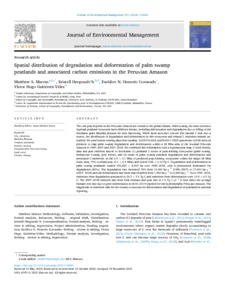Marcus Matthew S., Hergoualc'H Kristell Anaïk, Honorio Coronado Eurídice N., Gutiérrez-Vélez Víctor Hugo. 2024. Spatial distribution of degradation and deforestation of palm swamp peatlands and associated carbon emissions in the Peruvian Amazon. Journal of Environmental Management, 351:119665, 13 p.
![[img]](http://agritrop.cirad.fr/607690/1.hassmallThumbnailVersion/Marcus%20et%20al%2023%20Spatial%20distribution%20of%20degradation%20and%20deforestation%20of%20palm%20swamp%20peatlands%20and%20associated%20carbon%20emissions%20in%20the%20Peruvian%20Amazon.pdf)
|
Version publiée
- Anglais
Sous licence  . .
Marcus et al 23 Spatial distribution of degradation and deforestation of palm swamp peatlands and associated carbon emissions in the Peruvian Amazon.pdf Télécharger (8MB) | Prévisualisation |
Liste HCERES des revues (en SHS) : oui
Thème(s) HCERES des revues (en SHS) : Economie-gestion
Résumé : The vast peat deposits in the Peruvian Amazon are crucial to the global climate. Palm swamp, the most extensive regional peatland ecosystem faces different threats, including deforestation and degradation due to felling of the dominant palm Mauritia flexuosa for fruit harvesting. While these activities convert this natural C sink into a source, the distribution of degradation and deforestation in this ecosystem and related C emissions remain unstudied. We used remote sensing data from Landsat, ALOS-PALSAR, and NASA's GEDI spaceborne LiDAR-derived products to map palm swamp degradation and deforestation within a 28 Mha area of the lowland Peruvian Amazon in 1990–2007 and 2007–2018. We combined this information with a regional peat map, C stock density data and peat emission factors to determine (1) peatland C stocks of peat-forming ecosystems (palm swamp, herbaceous swamp, pole forest), and (2) areas of palm swamp peatland degradation and deforestation and associated C emissions. In the 6.9 ± 0.1 Mha of predicted peat-forming ecosystems within the larger 28 Mha study area, 73% overlaid peat (5.1 ± 0.9 Mha) and stored 3.88 ± 0.12 Pg C. Degradation and deforestation in palm swamp peatlands totaled 535,423 ± 8,419 ha over 1990–2018, with a pronounced dominance for degradation (85%). The degradation rate increased 15% from 15,400 ha y−1 (1990–2007) to 17,650 ha y−1 (2007–2018) and the deforestation rate more than doubled from 1,900 ha y−1 to 4,200 ha y−1. Over 1990–2018, emissions from degradation amounted to 26.3 ± 3.5 Tg C and emissions from deforestation were 12.9 ± 0.5 Tg C. The 2007–2018 emission rate from both biomass and peat loss of 1.9 Tg C yr−1 is four times the average biomass loss rate due to gross deforestation in 2010–2019 reported for the hydromorphic Peruvian Amazon. The magnitude of emissions calls for the country to account for deforestation and degradation of peatlands in national reporting.
Mots-clés Agrovoc : déboisement, télédétection, dégradation des forêts, écosystème forestier, Mauritia, tourbière, dégradation de l'environnement, distribution géographique, distribution spatiale, analyse économique, forêt tropicale humide, Landsat, gaz à effet de serre, technique analytique
Mots-clés géographiques Agrovoc : Amazonie
Mots-clés libres : CO2 emissions, Mauritia flexuosa, Tropical peatlands, Remote sensing, Unsustainable fruit harvesting, Land cover, Climate change
Agences de financement hors UE : Centre for International Forestry Research, Deutsche Gesellschaft für Internationale Zusammenarbeit, Direktoratet for Utviklingssamarbeid, United States Agency for International Development, Natural Environment Research Council
Auteurs et affiliations
- Marcus Matthew S., Temple University (USA) - auteur correspondant
- Hergoualc'H Kristell Anaïk, CIRAD-PERSYST-UMR Eco&Sols (FRA)
- Honorio Coronado Eurídice N., Université de St Andrews (GBR)
- Gutiérrez-Vélez Víctor Hugo, Temple University (USA)
Source : Cirad-Agritrop (https://agritrop.cirad.fr/607690/)
[ Page générée et mise en cache le 2024-04-29 ]





